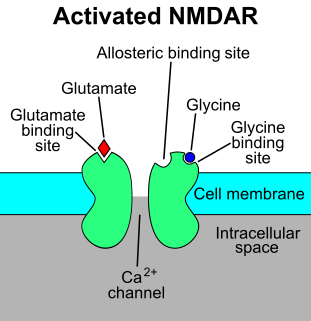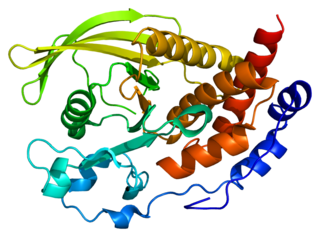Related Research Articles

The α-amino-3-hydroxy-5-methyl-4-isoxazolepropionic acid receptor is an ionotropic transmembrane receptor for glutamate (iGluR) that mediates fast synaptic transmission in the central nervous system (CNS). It has been traditionally classified as a non-NMDA-type receptor, along with the kainate receptor. Its name is derived from its ability to be activated by the artificial glutamate analog AMPA. The receptor was first named the "quisqualate receptor" by Watkins and colleagues after a naturally occurring agonist quisqualate and was only later given the label "AMPA receptor" after the selective agonist developed by Tage Honore and colleagues at the Royal Danish School of Pharmacy in Copenhagen. The GRIA2-encoded AMPA receptor ligand binding core was the first glutamate receptor ion channel domain to be crystallized.

The N-methyl-D-aspartatereceptor (also known as the NMDA receptor or NMDAR), is a glutamate receptor and ion channel found in neurons. The NMDA receptor is one of three types of ionotropic glutamate receptors, the other two being AMPA and kainate receptors. Depending on its subunit composition, its ligands are glutamate and glycine (or D-serine). However, the binding of the ligands is typically not sufficient to open the channel as it may be blocked by Mg2+ ions which are only removed when the neuron is sufficiently depolarized. Thus, the channel acts as a “coincidence detector” and only once both of these conditions are met, the channel opens and it allows positively charged ions (cations) to flow through the cell membrane. The NMDA receptor is thought to be very important for controlling synaptic plasticity and mediating learning and memory functions.
In neurophysiology, long-term depression (LTD) is an activity-dependent reduction in the efficacy of neuronal synapses lasting hours or longer following a long patterned stimulus. LTD occurs in many areas of the CNS with varying mechanisms depending upon brain region and developmental progress.
In neuroscience, a silent synapse is an excitatory glutamatergic synapse whose postsynaptic membrane contains NMDA-type glutamate receptors but no AMPA-type glutamate receptors. These synapses are named "silent" because normal AMPA receptor-mediated signaling is not present, rendering the synapse inactive under typical conditions. Silent synapses are typically considered to be immature glutamatergic synapses. As the brain matures, the relative number of silent synapses decreases. However, recent research on hippocampal silent synapses shows that while they may indeed be a developmental landmark in the formation of a synapse, that synapses can be "silenced" by activity, even once they have acquired AMPA receptors. Thus, silence may be a state that synapses can visit many times during their lifetimes.

An excitatory synapse is a synapse in which an action potential in a presynaptic neuron increases the probability of an action potential occurring in a postsynaptic cell. Neurons form networks through which nerve impulses travel, each neuron often making numerous connections with other cells. These electrical signals may be excitatory or inhibitory, and, if the total of excitatory influences exceeds that of the inhibitory influences, the neuron will generate a new action potential at its axon hillock, thus transmitting the information to yet another cell.

AP5 is a chemical compound used as a biochemical tool to study various cellular processes. It is a selective NMDA receptor antagonist that competitively inhibits the ligand (glutamate) binding site of NMDA receptors. AP5 blocks NMDA receptors in micromolar concentrations.

In excitotoxicity, nerve cells suffer damage or death when the levels of otherwise necessary and safe neurotransmitters such as glutamate become pathologically high, resulting in excessive stimulation of receptors. For example, when glutamate receptors such as the NMDA receptor or AMPA receptor encounter excessive levels of the excitatory neurotransmitter, glutamate, significant neuronal damage might ensue. Excess glutamate allows high levels of calcium ions (Ca2+) to enter the cell. Ca2+ influx into cells activates a number of enzymes, including phospholipases, endonucleases, and proteases such as calpain. These enzymes go on to damage cell structures such as components of the cytoskeleton, membrane, and DNA. In evolved, complex adaptive systems such as biological life it must be understood that mechanisms are rarely, if ever, simplistically direct. For example, NMDA in subtoxic amounts induces neuronal survival of otherwise toxic levels of glutamate.
Neuroprotection refers to the relative preservation of neuronal structure and/or function. In the case of an ongoing insult the relative preservation of neuronal integrity implies a reduction in the rate of neuronal loss over time, which can be expressed as a differential equation. It is a widely explored treatment option for many central nervous system (CNS) disorders including neurodegenerative diseases, stroke, traumatic brain injury, spinal cord injury, and acute management of neurotoxin consumption. Neuroprotection aims to prevent or slow disease progression and secondary injuries by halting or at least slowing the loss of neurons. Despite differences in symptoms or injuries associated with CNS disorders, many of the mechanisms behind neurodegeneration are the same. Common mechanisms of neuronal injury include decreased delivery of oxygen and glucose to the brain, energy failure, increased levels in oxidative stress, mitochondrial dysfunction, excitotoxicity, inflammatory changes, iron accumulation, and protein aggregation. Of these mechanisms, neuroprotective treatments often target oxidative stress and excitotoxicity—both of which are highly associated with CNS disorders. Not only can oxidative stress and excitotoxicity trigger neuron cell death but when combined they have synergistic effects that cause even more degradation than on their own. Thus limiting excitotoxicity and oxidative stress is a very important aspect of neuroprotection. Common neuroprotective treatments are glutamate antagonists and antioxidants, which aim to limit excitotoxicity and oxidative stress respectively.

The metabotropic glutamate receptors, or mGluRs, are a type of glutamate receptor that are active through an indirect metabotropic process. They are members of the group C family of G-protein-coupled receptors, or GPCRs. Like all glutamate receptors, mGluRs bind with glutamate, an amino acid that functions as an excitatory neurotransmitter.
Glutamate transporters are a family of neurotransmitter transporter proteins that move glutamate – the principal excitatory neurotransmitter – across a membrane. The family of glutamate transporters is composed of two primary subclasses: the excitatory amino acid transporter (EAAT) family and vesicular glutamate transporter (VGLUT) family. In the brain, EAATs remove glutamate from the synaptic cleft and extrasynaptic sites via glutamate reuptake into glial cells and neurons, while VGLUTs move glutamate from the cell cytoplasm into synaptic vesicles. Glutamate transporters also transport aspartate and are present in virtually all peripheral tissues, including the heart, liver, testes, and bone. They exhibit stereoselectivity for L-glutamate but transport both L-aspartate and D-aspartate.

NMDA receptor antagonists are a class of drugs that work to antagonize, or inhibit the action of, the N-Methyl-D-aspartate receptor (NMDAR). They are commonly used as anesthetics for animals and humans; the state of anesthesia they induce is referred to as dissociative anesthesia.
Gliotransmitters are chemicals released from glial cells that facilitate neuronal communication between neurons and other glial cells. They are usually induced from Ca2+ signaling, although recent research has questioned the role of Ca2+ in gliotransmitters and may require a revision of the relevance of gliotransmitters in neuronal signalling in general.

Glutamate [NMDA] receptor subunit epsilon-2, also known as N-methyl D-aspartate receptor subtype 2B, is a protein that in humans is encoded by the GRIN2B gene.

Cystine/glutamate transporter is an antiporter that in humans is encoded by the SLC7A11 gene.

Protein tyrosine phosphatase non-receptor type 5 is an enzyme that in humans is encoded by the PTPN5 gene.

Quinolinic acid, also known as pyridine-2,3-dicarboxylic acid, is a dicarboxylic acid with a pyridine backbone. It is a colorless solid. It is the biosynthetic precursor to niacin.

Nitromemantine is a derivative of memantine developed in 2006 for the treatment of Alzheimer's disease. It has been shown to reduce excitotoxicity mediated by over-activation of the glutamatergic system, by blocking NMDA receptors.

In neuroscience, glutamate refers to the anion of glutamic acid in its role as a neurotransmitter: a chemical that nerve cells use to send signals to other cells. It is by a wide margin the most abundant excitatory neurotransmitter in the vertebrate nervous system. It is used by every major excitatory function in the vertebrate brain, accounting in total for well over 90% of the synaptic connections in the human brain. It also serves as the primary neurotransmitter for some localized brain regions, such as cerebellum granule cells.

Hilmar Bading is a German physician and neuroscientist. His work on neuronal calcium signaling and gene regulation in the nervous system has been widely cited. He described the role of extrasynaptic NMDA receptors in neurodegenerative disorders and identified small molecule neuprotectants, named NMDAR/TRPM4 interface inhibitors. He is a member of the German National Academy of Science Leopoldina.
Acquired neuroprotection is a synaptic-activity-dependent form of adaptation in the nervous system that renders neurons more resistant to harmful conditions. The term was coined by Hilmar Bading. This use-dependent enhancement of cellular survival activity requires changes in gene expression triggered by neuronal activity and nuclear calcium signaling. In rodents, components of the neuroprotective gene program can reduce brain damage caused by seizure-like activity or by a stroke. In acute and chronic neurodegenerative diseases, gene regulatory events important for acquired neuroprotection are antagonized by extrasynaptic NMDA receptor signaling leading to increased vulnerability, loss of structural integrity, and bioenergetics dysfunction.
References
- ↑ Tovar, Kenneth R.; Westbrook, Gary L. (2002-04-11). "Mobile NMDA receptors at hippocampal synapses". Neuron. 34 (2): 255–264. doi: 10.1016/s0896-6273(02)00658-x . ISSN 0896-6273. PMID 11970867.
- ↑ Petralia, R. S.; Wang, Y. X.; Hua, F.; Yi, Z.; Zhou, A.; Ge, L.; Stephenson, F. A.; Wenthold, R. J. (2010-04-28). "Organization of NMDA receptors at extrasynaptic locations". Neuroscience. 167 (1): 68–87. doi:10.1016/j.neuroscience.2010.01.022. ISSN 1873-7544. PMC 2840201 . PMID 20096331.
- ↑ Hardingham, G. E.; Fukunaga, Y.; Bading, H. (2002-05-01). "Extrasynaptic NMDARs oppose synaptic NMDARs by triggering CREB shut-off and cell death pathways". Nature Neuroscience. 5 (5): 405–414. doi:10.1038/nn835. ISSN 1097-6256. PMID 11953750. S2CID 659716.
- ↑ Okamoto, Shu-ichi; Pouladi, Mahmoud A.; Talantova, Maria; Yao, Dongdong; Xia, Peng; Ehrnhoefer, Dagmar E.; Zaidi, Rameez; Clemente, Arjay; Kaul, Marcus (2009-12-01). "Balance between synaptic versus extrasynaptic NMDA receptor activity influences inclusions and neurotoxicity of mutant huntingtin". Nature Medicine. 15 (12): 1407–1413. doi:10.1038/nm.2056. ISSN 1546-170X. PMC 2789858 . PMID 19915593.
- ↑ Milnerwood, Austen J.; Gladding, Clare M.; Pouladi, Mahmoud A.; Kaufman, Alexandra M.; Hines, Rochelle M.; Boyd, Jamie D.; Ko, Rebecca W. Y.; Vasuta, Oana C.; Graham, Rona K. (2010-01-28). "Early increase in extrasynaptic NMDA receptor signaling and expression contributes to phenotype onset in Huntington's disease mice". Neuron. 65 (2): 178–190. doi: 10.1016/j.neuron.2010.01.008 . ISSN 1097-4199. PMID 20152125.
- ↑ Talantova, Maria; Sanz-Blasco, Sara; Zhang, Xiaofei; Xia, Peng; Akhtar, Mohd Waseem; Okamoto, Shu-ichi; Dziewczapolski, Gustavo; Nakamura, Tomohiro; Cao, Gang (2013-07-02). "Aβ induces astrocytic glutamate release, extrasynaptic NMDA receptor activation, and synaptic loss". Proceedings of the National Academy of Sciences of the United States of America. 110 (27): E2518–2527. Bibcode:2013PNAS..110E2518T. doi: 10.1073/pnas.1306832110 . ISSN 1091-6490. PMC 3704025 . PMID 23776240.
- ↑ Hardingham, Giles E.; Bading, Hilmar (2010-10-01). "Synaptic versus extrasynaptic NMDA receptor signalling: implications for neurodegenerative disorders". Nature Reviews. Neuroscience. 11 (10): 682–696. doi:10.1038/nrn2911. ISSN 1471-0048. PMC 2948541 . PMID 20842175.
- ↑ Parsons, Matthew P.; Raymond, Lynn A. (2014-04-16). "Extrasynaptic NMDA receptor involvement in central nervous system disorders". Neuron. 82 (2): 279–293. doi: 10.1016/j.neuron.2014.03.030 . ISSN 1097-4199. PMID 24742457.
- ↑ Yan, Jing; Bengtson, C. Peter; Buchthal, Bettina; Hagenston, Anna M.; Bading, Hilmar (9 October 2020). "Coupling of NMDA receptors and TRPM4 guides discovery of unconventional neuroprotectants". Science. 370 (6513): eaay3302. doi:10.1126/science.aay3302. ISSN 1095-9203. PMID 33033186. S2CID 222210921.
- ↑ Yan, Jing; Bengtson, C. Peter; Buchthal, Bettina; Hagenston, Anna M.; Bading, Hilmar (9 October 2020). "Coupling of NMDA receptors and TRPM4 guides discovery of unconventional neuroprotectants". Science. 370 (6513): eaay3302. doi:10.1126/science.aay3302. ISSN 1095-9203. PMID 33033186. S2CID 222210921.
- ↑ "New Class of Highly Effective Inhibitors Protects against Neurodegeneration – Heidelberg University". www.uni-heidelberg.de. Retrieved 2020-10-29.